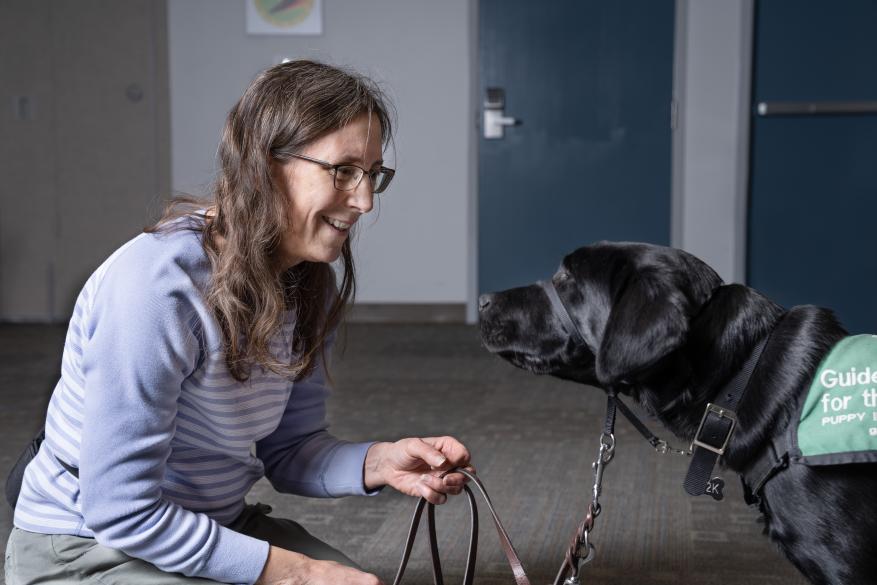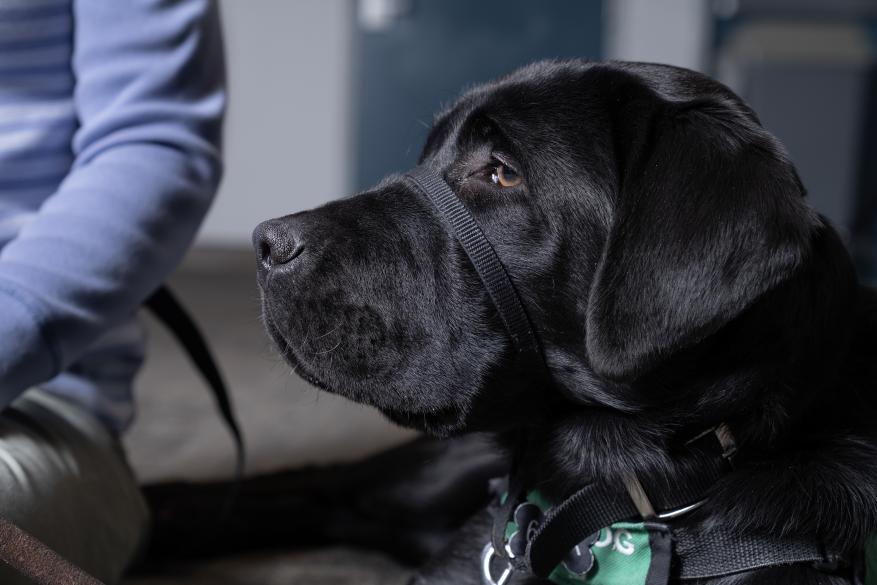More than 30 years ago, Kristi Swope listened intently to a dinner presentation about the need for volunteers to train puppies as service animals.
It was then that a seed was planted for her future, as she told herself, “This is something I’d like to do someday.”
Now, more than three decades later, the Z-Program analyst is living the dream — raising puppies to become service animals for San Rafael-based Guide Dogs for the Blind, an organization founded in 1942.
“I never wanted two dogs at the same time and I had a pet dog until several years ago. Two years ago, I didn’t have a pet and I decided, now is the time for me to raise a service animal,” Swope said.
As puppies raised for Guide Dogs for the Blind need to be with their trainers 24 hours a day, seven days a week, Swope had one hurdle to overcome before she could start — obtaining permission to bring her dogs to work at the Laboratory.
A nearly 23-year Lab employee, Swope spoke with her Z Program management and her managers were supportive of her guide dog training efforts, giving her the green light. She has even been given an ABC (Accompanied By Canine) badge from the West Gate Badge Office.
“I need to have the dog with me all the time, so that I can socialize him. The point of the socialization is to expose the dogs to a variety of environments, so that when they’re with a client, even if the environment is new, the dog is still comfortable,” Swope said.
As the largest guide school in North America, with more than 16,000 canine graduates, Guide Dogs for the Blind breeds their own dogs, Labradors and Golden Retrievers.
“My understanding is that one reason they breed these dogs is that they are food motivated and they’re easier to train because you can make training a positive experience,” Swope said. “The dogs are always thinking, ‘What do I have to do for my next treat?’”
“Another reason they breed these dogs is that they are more approachable than some other dogs, such as possibly German Shepherds. They look more friendly.”
After a puppy is born, Guide Dogs for the Blind names the dog and the pup begins life with a starter puppy raiser, who raises the dog from eight weeks to five months, house-breaking the dog and teaching the dog to observe simple commands, such as sit, down, stay and come.
Swope is a finisher puppy raiser and her work from about five months to 16 months with her current dog Galway, a male black Labrador, focuses on continuing with the basic commands and socializing the puppy.
Once Swope and other finisher puppy raisers complete their time with their dogs, the animals go back for formal training to Guide Dogs for the Blind facilities in San Rafael and Boring, Oregon.
“When they go into their formal training, they learn much more. For example, we can’t take them on escalators; that’s one thing they learn as well as alerting their sight-impaired clients that there’s an obstacle in their path.”
In their formal training, they also learn “intelligent disobedience” — such as refusing a client’s command to cross the street when the dog recognizes a car is coming.
Swope and her charge are members of the Pleasanton Puppy Club, which meets twice a month on Tuesdays.
One Tuesday each month is dedicated to outings, such as trips to the hardware store, the pet store (for a bath), a downtown Livermore walk and a jaunt down Candy Cane Lane in Pleasanton. Some of Galway’s other adventures have included trips to a department store, a drug store, a movie theater, parks, a restaurant and elementary schools in Livermore and San Ramon.
During the other monthly Tuesday meetings, Swope and other dog owners run their dogs through training sessions on particular topics, such as polite greetings of people, polite greetings of other dogs, blind awareness exercises for humans and basic commands.
“When I go shopping, I always need to use a cart rather than a shopping basket. Wherever I go, it’s important for me to have a free hand so that I can reward the dog,” Swope said. “Every normal activity is now different.
“It’s a person’s job to know where they’re going and how to get there; it’s the dog’s job to get them there safely.”
The Lab employee received her first dog to train, Hiker, a blonde female Labrador, on Dec. 31, 2021 and worked with her until June 2022. Between June and October of last year, when she started teaming with Galway, she performed puppy-sitting for three different puppies, whose trainers had gone on vacation or were taking a break.
“There are people who don’t know that a guide dog in training should not be disturbed. Guide dogs in training also are working and so people should ignore them the way they would already-trained service dogs that are working,” Swope said.
“When I make progress with the dog and I see him learning something, it’s very rewarding to me.”
Swope, who will be training Galway until about October of this year, enjoys bringing her canine companion to her office in Bldg. 140. “It’s fun because sometimes when I’m walking in the building and I turn a corner, a colleague breaks out in a smile when they see the dog. I could even see their smiles when we were all wearing our masks.”
If Guide Dogs for the Blind sees that a dog may not be a good fit for sight-impaired people, the organization may transfer the dog to another organization that trains dogs for other purposes, such as to provide diabetic or seizure alerts (based on chemical scents).
Swope said that although she’s found working with Galway and other dogs to be a lot of work, she’s learned much and found their interactions “quite rewarding.”
“While it’s hard to say good-bye to a dog you’ve raised, it makes it all worthwhile to know that the dog is going on to improve someone else’s life.”
Now that Swope is living her dream after more than three decades, she anticipates continuing to raise other dogs for Guide Dogs for the Blind to help people for years to come.







